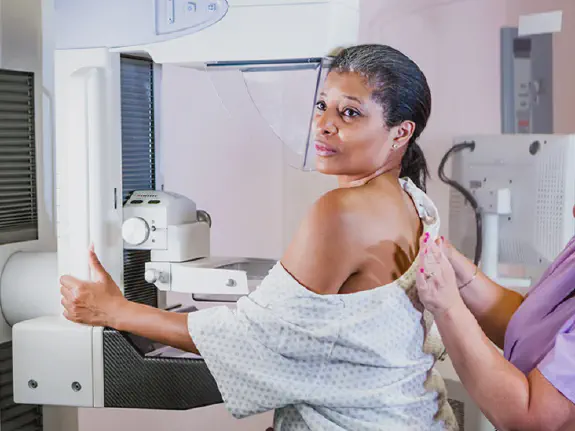Sex and Gender-based Analysis of this topic
Definition
Breast cancer results from malignant tumours that have developed from breast cells. The type of breast cancer is usually classified based on the breast tissue where it first originates, such as lobular carcinoma, which starts in the lobules where milk is produced. The most common type of breast cancer is ductal carcinoma, which starts in the ducts that carry milk to the nipple[1]. Breast cancer is the most commonly diagnosed cancer in women and is the second most common cause of cancer death after lung cancer. Although the number of deaths due to breast cancer is declining in all age groups, it remains the most common cancer cause of death for women under 50 years[2].
Screening mammography can find breast cancer not detected through breast examinations, which makes this an important screening tool to reduce breast cancer mortality. Women between the ages of 50 and 69 are recommended to have a screening mammography at least once every two years based on personal risk factors and the advice of their health care provider. Specifically, mammography screening reduces breast cancer mortality by 30% in women aged 50-69[3].
Sex Issues
Breast cancer is very rare for men; 99% of breast cancers occur in women. Some of the important risk factors for women include: increased age, close relatives with breast cancer, never breastfeeding, having a first baby after age 30 or never having a baby, North American or Northern European country of birth, menstruation before age 12, menopause after age 55, excess weight, taking some types of hormone replacement therapies for long periods of time, and exposure of the breast to high levels of radiation[4]. Other possible risk factors include drinking alcohol, smoking or being exposed to second-hand smoke, being physically inactive, and using birth control pills[5]. Recent research has found that depending on the woman’s age, 16-30% of breast cancer can be attributed to women with extensive dense breast tissue, which may be difficult to detect in a mammogram[6].
Gender Issues
A woman’s relationship with her breasts is an important factor in terms of breast cancer screening. Many women fear losing their breasts from breast cancer, and thus, losing their womanhood, more than they fear dying from breast cancer. This may help explain why women do not participate in regular mammogram screening. The actual mammogram examination can be a source of embarrassment and discomfort due to impersonal technologists or deeply engrained concerns about body image, which may deter women from coming back for future mammograms. Furthermore, the portrayal of mammograms as being much more painful than they actually are in the public media also acts as a deterrent.
Diversity
Women with low incomes and lower levels of education have fewer mammograms[7]. Women in rural or remote communities may have limited access to screening services. LGBTQ populations have less access to routine medical care due to fear of discrimination and negative problems with their health care providers which results in low rates of health services utilization, including cancer screening. For example, based on data from the 2003 and 2005 Canadian Community Health Survey, bisexual women between 50 and 59 years of age were less likely to have had a mammogram in the two years prior to the survey. As well, women with disabilities and women with breast implants often do not access screening.
Critique
Accessing provincial or national screening data on hard-to-reach populations is difficult due to restrictions on data access.
